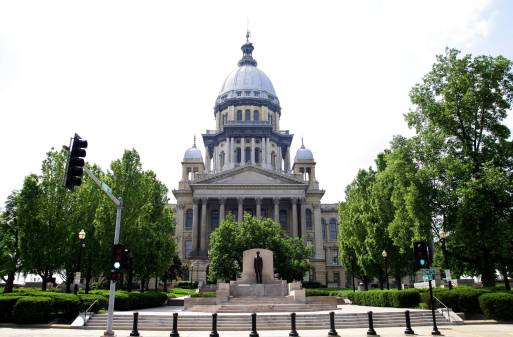Q&A: Illinois CIO Hardik Bhatt shares his vision of state government’s pivotal role in emerging tech

In an interview earlier this month, StateScoop caught up with Illinois Chief Information Officer Hardik Bhatt, one of the nation’s most collaborative and forward-thinking technology leaders. He shared his enthusiasm for putting business needs first and imparted his philosophy on the role state governments should play as public-sector leaders from around the country consider the buffet of technologies available. He also had some news to share: Illinois is using statewide joint procurement authority to bring smart street light technology to smaller municipalities as one piece of their Smart State initiative.
StateScoop: So, I just saw something online about 7G wireless. As a CIO, how do you decide what’s worth paying attention to and what’s just hype?
Hardik Bhatt: In our case, most of how we approach is not starting with technology, but start with the problem we are trying to solve. So, in Illinois we are trying to keep the citizen at the center of everything that we are trying to do. So, we look at how can we — one — make the government most efficient, and — two — improve our services to our citizens and provide them in the way they want these services from the government.
So I’ll definitely not look at whether it is 5G, 4G, 7G — I look at how does the citizen want to communicate with us and what’s the best available technology out there that I can apply, obviously with ROI right in the center. Generally, what we do when it comes to bleeding edge is we do RFIs or we try to get as much information as possible, try a couple of pilots, but bleeding edge we don’t invest significantly in. But leading edge, yes, we do.
SS: Like blockchain. Aside from Delaware, Illinois is one of the only governments to look seriously at that technology.
HB: That’s a great example you brought up. The way we actually got onto that was a couple of our departments — the Department of Insurance and the Department of Financial and Professional Regulation — they approached us and they said that we are getting approached by entities that we regulate, like insurance companies, and they are talking about this new thing about blockchain. Fortunately we had a couple experts on the team that knew about it, so they started investigating more and we realized that this was really a completely new area and it has a potential of major disruption if adoption is close.
So, it’s important for us to start understanding what the technology does. How does that impact the entities that we regulate? Is there any application of [blockchain] that is inside the government? How do we know those things?
So we went out and did a few things there, published requests for information, published a request for comment and also basically started having a lot of conversations. We formed a working group. All of those help us get up to speed with what is happening because if we are going to regulate something, I think that we would want to know what it is that we are regulating, why we are regulating it, how we are regulating it and how it can be regulated most effectively.
So at this point, it’s information gathering and seeing what everybody else is doing. At some point in the future, we might test it out. Most of the time, my philosophy is government should be out of things as much as it can before it really knows what it is the role that government is going to play.
SS: The federal government sometimes leads on technology with things like cloud-first, and cities are often well-positioned to lead in other areas. What role should states play when it comes to emerging technology?
HB: I think it depends on what you do, right? Cities are taking lead on a lot of stuff that is directly related to the citizen on the street. So using cameras in cars or using sensors on the light poles — that’s what they do.
As it comes to the federal government, they are the facilitator of everything that goes on nationally, so entities like NTIA or NIST within the Department of Commerce, they help define these national standards and those kind of things. It is rare where the federal government comes up with cloud-first or something like that — that doesn’t happen that regularly.
Where states come in is we regulate the energy industry, we regulate the insurance industry, the businesses, the licenses we issue. So, when it comes to innovation in that area, that’s where we are.
It depends on what your core area that you’re focusing on as a government and that’s where you need to continue looking out for innovative technology that can make you more efficient and improve your service.
SS: What about the Illinois Smart State initiative? What do you hope this will accomplish?
HB: We are looking at a three-pronged approach for Smart State. One is the state as a customer — so taking smart city solutions in state government and making it more efficient. If you look at our new tollway, there’s a lot of technology when it comes to intelligent transportation systems [ITS] that are used in there. There’s fiber along the route, there are intelligent messaging signs, there’s a lot of technology that’s used that’s kind of “the new ITS.” Also, using things like analytics and data sharing to improve decision-making, improve information.
Our Department of Corrections is working with county governments to share information of offenders between various jurisdictions so that you can track an offender from arrest to parole.
When I say Smart State and making government efficient, it’s not just the sensors. It’s sensors, mobile, analytics, cybersecurity, blockchain, all of them — how can we use that to make the government efficient?
The second aspect is the economy and talent and everything else. What can we do to make sure that we are using innovation and technology for an improved economy? So if you catch the [Illinois’] State of the State address from Gov. [Bruce] Rauner, you will hear a lot about how he sees innovation and technology in play and the research and the role that state government plays in building that compassionate and competitive economy of the state.
And the third one is around — how do we make sure that the smaller villages and municipalities are also playing a role in the smart cities area?
We are using statewide joint procurement authority to create a level playing field for small and medium-sized municipalities. On [last] Monday, we published a request for proposal for smart street lighting. The state of Illinois is not in the business of managing street lights, other than on the expressways and tollways, but every municipal government or school district or university campus — they do manage street lights. So through this RFP, we are going to have up to three vendors on contract and any government in Illinois can then go through these three vendors and ask them to bid for retrofitting their streetlights to be LED-enabled, with adaptive controls, remotely-manageable sensor streetlights. Each of them can give anywhere between 30 to 50 percent energy efficiency [gains] as we start rolling this out. Now, this is a game-changing thing, because smaller municipalities would have a tough time being attractive for companies to come in and provide them solutions, and in our case, we are keeping the business model open so if the municipalities want to purchase a solution outright, they can. If they want to purchase a street light as a service, they can do that. If they want to go for a public-private partnership option, they can go there.
So again, that’s the third part where the state of Illinois, through its procurement authority plays the role of a demand-aggregator or an equalizer and plays a role as a platform.
That’s — to me — where we can get the entire state smart and not just the pockets of smartness that we have been seeing around the globe when it comes to smart cities.
S: Other than what we’ve been talking about so far, are there any emerging technologies that you are keeping your eye on or that you are particularly hopeful for?
HB: I have heard of North Carolina using chatbots for better customer service. People have to stay on hold for a long time, and you don’t have a customer service representative and a lot of private sector companies are using these chatbots that can help you for your simple questions and then if that cannot help, they can turn you over. The customers we work with generally are not that technology savvy, but a lot more people now use smartphones, use technology, use computers, so that would be a technology that we’d be looking into in 2017.
We have an innovation center, set up now within the government, which in 2017 is going to look through all of these emerging technologies and compare to the pains that we have in terms of inefficiency within the government or poor customer service and see if these things can apply and we’ll test those things out through the ideation sessions, through the pilots, through the innovation center. Again, it will be driven heavily by the business need, as opposed to what technology has to offer.
This interview has been edited lightly for clarity.






